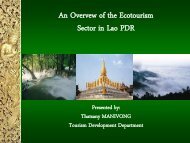GEOLOGY OF THE PENGKALAN HULU-BETONG TRANSECT ...
GEOLOGY OF THE PENGKALAN HULU-BETONG TRANSECT ...
GEOLOGY OF THE PENGKALAN HULU-BETONG TRANSECT ...
Create successful ePaper yourself
Turn your PDF publications into a flip-book with our unique Google optimized e-Paper software.
Basir Jasin (1995) reported the occurrence of Early Carboniferous radiolarian in the<br />
chert of the Kubang Pasu Formation. Basir Jasin and Zaiton Harun (2001) confirmed the<br />
earlier finding and they also reported the occurrences of Albailella indensis-rota<br />
Assemblage Zone in the chert representing the lower part of the Kubang Pasu Formation<br />
at Bukit Binjal, Kedah. This confirms that the age of the Kubang Pasu Formation is late<br />
Tournaisian (Early Carboniferous).<br />
The Transect area on the Thai side was first mapped by the then Geological Survey<br />
Division, Department of Mineral Resources Thailand (Muenlek et al., 1979) on scale<br />
1:250,000 at Sheet NB 47-85 (Changwat Narathiwat and Takbai District; reprinted in<br />
1985) and Sheet NB 47-12 (Betong District; reprinted in 1985). Muenlek et al. (1979)<br />
introduced the Silurian-Devonian rocks as the Ban To and Betong Formations. The<br />
former consists of recrystallized limestones to marble, quartzite, phyllite, phyllitic schist<br />
and mica-schist, and the latter comprises shales with Tentaculites elegans, cherts,<br />
siliceous shales, meta-tuff, carbonaceous shales, argillite, mudstones, sandstones and<br />
bedded recrystallized limestones.<br />
Hutchison and Taylor (1978) proposed three geographical granite belts in Malaysian<br />
peninsula based on lithology and petrochemistry of the granite. The Eastern belt<br />
granitoids are composed mostly of I-type, magnetite series granitoids. The Main Range<br />
granitoids in the central belt are composed mainly of S-type, ilmenite series granitoids<br />
with minor intrusion of I-type, magnetite series granitoids. The western belt granitoids<br />
consist of both I-type, magnetite series granitoids and S-type, ilmenite series granitoids.<br />
Muenlek et al. (1982) published a regional geological map, Narathiwat sheet scale<br />
1:250,000. The individual granite pluton was preliminarily studied petrographically, and<br />
subsequently three granite phases were classified as gneissic granite, coarse-grained<br />
porphyritic biotite granite and tourmaline-muscovite granite.<br />
Cobbing et al. (1986) studied petrography, geochemistry, and Rb/Sr age determination<br />
of the granites of the South East Asian tin belt. They suggested that the granites in the<br />
east coast of Thai-Malay peninsula are mainly Triassic in age. The granite within the<br />
Transect area can be classified as a Triassic Main Range Granite or Triassic Central Belt<br />
Granite.<br />
Nakapadungrat et al. (1988) introduced the Carboniferous rock sequences cropping out<br />
in Sabayoi Quadrangle, Thailand as the Yaha Formation, which can be correlated with the<br />
Kubang Pasu Formation on the Malaysian side.<br />
Sashida et al. (1998) reported the occurrence of Early Carboniferous radiolarians in<br />
chert lenses intercalated with sandstone and siltstone-dominated sequence at Ban Wang<br />
Yai, 12 km east of Na Thawi District and Ban Kabang of Kabang District, Yala Province.<br />
These radiolarians are Eutactinia varispina, E. vulgaris, Astroentactinia multispinosa,<br />
Spongentactinia sp., and Triaenospaera sp. indicative of an Early Carboniferous age of<br />
Tournaisian stage (Sashida et al., 2000).<br />
Charusiri, B & Charusiri, P. (1990) studied the geology and Sn-minineralization at Pin<br />
Yo mine in the Tham Talu mineralization zone. They concluded that the Sn- and Bamineralization<br />
could be classified as a metasomatic exoskarn in contact zone of Triassic<br />
granite and Permian limestone.<br />
Tonnayopas (1994) studied the geology and stratigraphy of the Bang Lang Dam area<br />
situated in the northeastern part of the Transect area. He suggested that sequence of<br />
mainly sandstone, shale, argillite and schist in the Bang Lang Dam site area could be<br />
identified to the Kanchanaburi Formation introduced by Javanaphet (1969); with igneous<br />
intrusion in the west of the dam site. Tonnayopas (1994) separated the Kanchanaburi<br />
5



